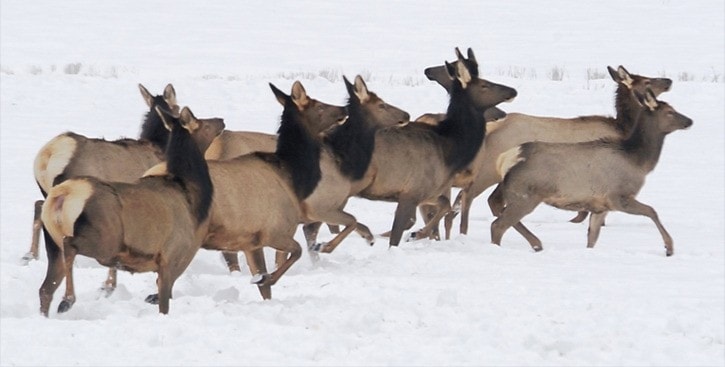 Years ago a friend related to me an account of what they may have thought was a winter oddity. As I remember them saying, they were headed up to their winter camp to do some sort of logging. There was a lot of snow. When at the camp, they spotted what looked like steam coming from the top of a snow-blanketed pile of brush. In the dead of winter, I have seen smoke and felt nice warm air coming from snow-covered burn piles left over from logging operations. But, although I have found holes in the snow where warm air was coming from some little creature’s winter nest, I have never seen vapour coming from the top of a mound of snow.
Years ago a friend related to me an account of what they may have thought was a winter oddity. As I remember them saying, they were headed up to their winter camp to do some sort of logging. There was a lot of snow. When at the camp, they spotted what looked like steam coming from the top of a snow-blanketed pile of brush. In the dead of winter, I have seen smoke and felt nice warm air coming from snow-covered burn piles left over from logging operations. But, although I have found holes in the snow where warm air was coming from some little creature’s winter nest, I have never seen vapour coming from the top of a mound of snow.
Now, mammals and birds, and other creatures too, as winter approaches, don’t always end up where they are “supposed” to end up or reach the environment, destination or the state of being usually attained by their kind. There may be the odd hummingbird hanging around in the winter (probably due to someone’s negligence in taking down the feeder in late summer). A singular bird or small group of birds, normally spending winter on the west side of the Pacific Ocean, end up spending the winter on the east side. Some creatures that hibernate deep in burrows might get flooded out, ending up spending winter in less favorable or desirable accommodations.
Back at the snow-covered brush pile, an investigation was undertaken to determine the source of the vapour. Somehow, and unfortunately, perhaps with a machine, they lifted the pile of brush. Out came a very bewildered and sleepy-eyed Ursus americanus (black bear). It wandered off to find another spot. It may not have survived the rest of the winter unless it found another sheltered location.
It seems to me a safer and drier place for a bear to spend the winter would be in a hole in the ground or a bank well protected at the entrance with large tree roots and perhaps boulders. It might well be that this bear had taken up winter residence on the edge of another bear’s range and was forced to pick this less secure stronghold to safely pass the winter.
For some creatures, the solution for winter isn’t to hibernate but just to sleep it off or spend the colder days sleeping while coming out on sunny days to feed. Tree squirrels do that quite a bit. There must be some birds that truly hibernate but, at the moment, I am not recalling any that do, but some birds do apparently “sleep” for extended periods. I recall an incident where it was reported that many more than a dozen or so birds were spending the winter sleeping in a cave somewhere in the southwestern United States. These birds, either swallows or rosy finches (a.k.a. gray-crowned rosy finches) were safely lodged, while outside the cave the climate was such they wouldn’t have survived.
Usually one doesn’t have to go very far, in this area, to find evidence of ways, outside of migrating, in which members of the animal kingdom face winter. But a perhaps not so rare breed of birdwatchers, often referred to as “listers” will sometimes go a long, long way to see a winter oddity. One case is that of a spoon-billed sandpiper that got mixed up in its directions and, instead of migrating down the west coast of the Pacific, flew down the east coast and ended up on some mud flats near Vancouver.
That, indeed, was apparently a very unusual place for that species to spend the winter and one bird watcher, hearing of the plight way over in Florida, just had to get this one on his list. He immediately boarded a plane, and, after landing at Vancouver airport, taxied out to George C. Reifel Migratory Bird Sanctuary and went looking for this very distinguished sandpiper. He saw it and without having to make a trip to the other side of the Pacific Ocean! He promptly got in the waiting taxi and headed for the airport and took the next plane home. That was a fast trip!
Some people get more excited about what is going on in someone else’s backyard than what’s happening in their own. But that is OK. There are reasons to travel and reasons not to travel.
There is an opportunity coming up to find out what is going on in Creston’s backyard in the way of winter and Christmas birds. At 8 a.m. Dec. 27, people gung ho about finding who is here for the winter will meet at the Trinity United Church to head out for the annual Christmas Bird Count. If you would like to participate, and get some fresh air and other perks to boot, and would like information, call Sharon at 250-428-7289.
Is Creston too far to “fly”? Well, then, you can count birds in your own backyard and at your feeder. For that, call Catherine at 250-428-8435 for information. Wherever you check on the birds, you are bound to be in for some surprises!
Ed McMackin is a biologist by profession but a naturalist and hiker by nature. He can be reached at 250-866-5747.
